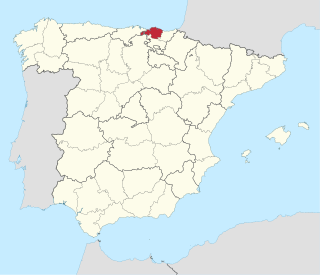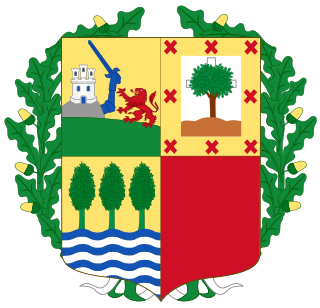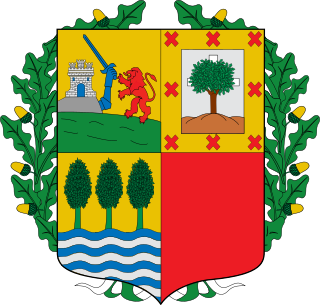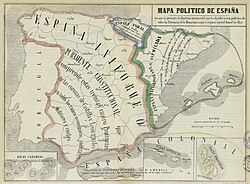
In Spain, an autonomous community is the first-level political and administrative division, created in accordance with the Spanish Constitution of 1978, with the aim of guaranteeing limited autonomy of the nationalities and regions that make up Spain.

Biscay is a province of Spain and a historical territory of the Basque Country, heir of the ancient Lordship of Biscay, lying on the south shore of the eponymous bay. The capital and largest city is Bilbao.

Basque nationalism is a form of nationalism that asserts that Basques, an ethnic group indigenous to the western Pyrenees, are a nation and promotes the political unity of the Basques, today scattered between Spain and France. Since its inception in the late 19th century, Basque nationalism has included separatist movements.

The Basque Nationalist Party, officially Basque National Party in English, is a Basque nationalist and regionalist political party. The party is Christian-democratic, with social-democratic and conservative-liberal factions. It operates in all the territories comprising the Basque Country: the Basque Autonomous Community and Navarre in Spain, and in the French Basque Country. It also has delegations in dozens of foreign nations, specifically those with a major presence of Basque immigrants.

The Basque Country is the name given to the home of the Basque people. The Basque country is located in the western Pyrenees, straddling the border between France and Spain on the coast of the Bay of Biscay. Euskal Herria is the oldest documented Basque name for the area they inhabit, dating from the 16th century.

Fuero, Fur, Foro or Foru is a Spanish legal term and concept. The word comes from Latin forum, an open space used as a market, tribunal and meeting place. The same Latin root is the origin of the French terms for and foire, and the Portuguese terms foro and foral; all of these words have related, but somewhat different meanings.

The Third Carlist War (1872–1876) was the last Carlist War in Spain. It is sometimes referred to as the "Second Carlist War", as the earlier "Second" War (1847–1849) was smaller in scale and relatively trivial in political consequence.

The Statute of Autonomy of the Basque Country of 1979, widely known as the Statute of Gernika, is the legal document organizing the political system of the Autonomous Community of the Basque Country' which includes the historical territories of Alava, Biscay and Gipuzkoa. It forms the region into one of the autonomous communities envisioned in the Spanish Constitution of 1978. The Statute was named "Statute of Gernika" after the city of Gernika, where its final form was approved on 29 December 1978. It was ratified by referendum on 25 October 1979, despite the abstention of more than 40% of the electorate. The statute was accepted by the lower house of the Spanish Parliament on November 29 and the Spanish Senate on December 12.

Spain is a diverse country integrated by contrasting entities with varying economic and social structures, languages, and historical, political and cultural traditions. According to the current Spanish constitution, the Spanish nation is the common and indivisible homeland of all Spaniards, composed of nationalities and regions which the constitution recognizes and guarantees the right of self-government.

Carlos Garaikoetxea Urriza is a former politician from the Spanish Basque Country. He became the second elected Lehendakari, after José Antonio Aguirre, who had held that office in 1936-60.

The Basques are an indigenous ethno-linguistic group mainly inhabiting Basque Country. Their history is therefore interconnected with Spanish and French history and also with the history of many other past and present countries, particularly in Europe and the Americas, where a large number of their descendants keep attached to their roots, clustering around Basque clubs which are centers for Basque people.

The Southern Basque Country is a term used to refer to the Basque territories within Spain as a unified whole.

The current Basque coat of arms is the official coat of arms of the Basque Country, Autonomous community of Spain. It consists of a party per cross representing the three historical territories of Álava, Gipuzkoa and Biscay, as well as a fourth, void quarter. The arms are ringed by a regal wreath of oak leaves, symbolic of the Gernikako Arbola. The fourth quarter constituted since the late 19th century the linked chains of Navarre; however, following a legal suit by the Navarre Government claiming that the usage of the arms of a region on the flag of another was illegal, the Constitutional Court of Spain ordered the removal of the chains of Navarre in a judgement of 1986.

The Basque Country, also called Basque Autonomous Community, is an autonomous community of Spain. It includes the provinces of Álava, Biscay, and Gipuzkoa, located in the north of the Iberian Peninsula, bordering on the autonomous communities of Cantabria, Castile and León, La Rioja, and Navarre, and the French region of Nouvelle-Aquitaine.
The Economic Agreement is a juridical instrument that regulates the taxation and financial relations between the General Administration of the Kingdom of Spain and the Autonomous Community of the Basque Country.
The General Assembly is the name of the legislative body (legislature) of the territories of Biscay, Gipuzkoa, Alava and Navarre, and the elected assemblies to which the Government of each territory is responsible.

The 1833 territorial division of Spain divided the country into provinces, in turn classified into "historic regions". This division was followed by the ensuing creation of provincial deputations, the government institutions for most of the provinces, remaining up to this date. Nearly all of the provinces retain roughly or precisely the 1833 borders. Conversely, many of the historic regions correspond to present-day autonomous communities.

The political division of the Kingdom of Spain is defined in Part VIII of the Spanish constitution of 1978, which establishes three levels of territorial organization: municipalities, provinces and autonomous communities, the first group constituting the subdivisions of the second, and the second group constituting the subdivisions of the last. The State guarantees the realization of the principle of solidarity by endeavouring to establish an economic balance between the different areas of the Spanish territory.
Basque civil law is the civil law partially applicable in the Spanish part of the Basque Country.
The end of Basque home rule or fueros in Spain was a process coming to a head in the period extending from the First Carlist War (1833-1840) to the aftermath of the Third Carlist War (1876-1878). It brought to an end the status of sovereignty coupled with allegiance to the Crown of Castile held by the different Basque territories for centuries. In the French Basque Country, home rule was abruptly suppressed during the French Revolution.












